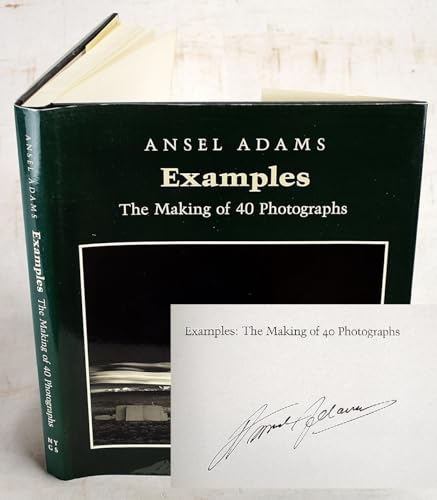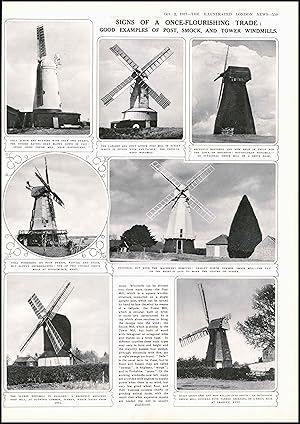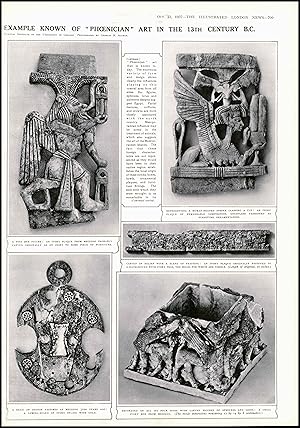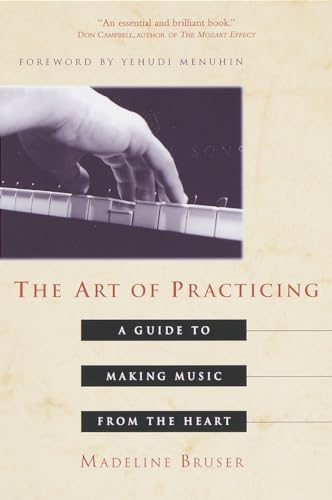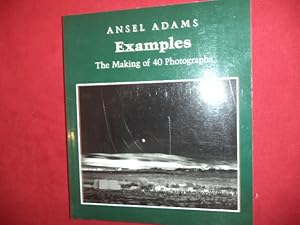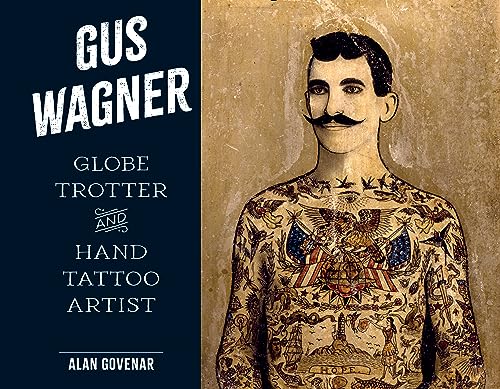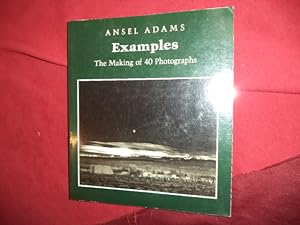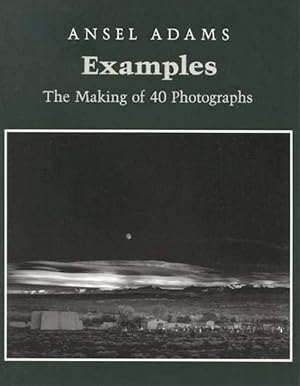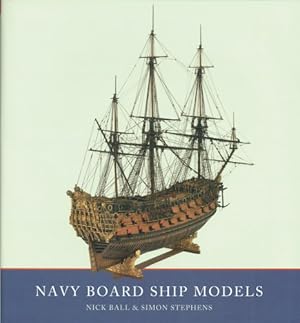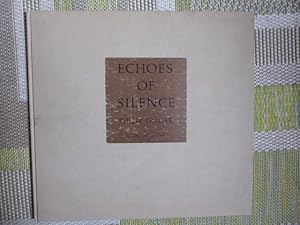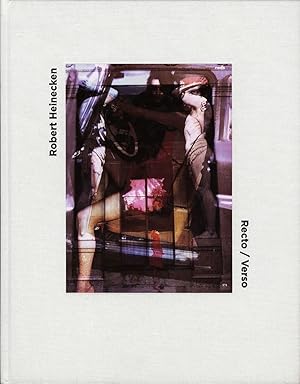Examples the Making of 40 Photographs (197 results)
Product Type
- All Product Types
- Books (197)
- Magazines & Periodicals
- Comics
- Sheet Music
- Art, Prints & Posters
- Photographs
- Maps
-
Manuscripts &
Paper Collectibles
Condition
Binding
Collectible Attributes
- First Edition (34)
- Signed (7)
- Dust Jacket (33)
- Seller-Supplied Images (65)
- Not Printed On Demand (192)
Free Shipping
Seller Location
Seller Rating
-
Examples: The Making of 40 Photographs
Published by Ansel Adams, 1989
ISBN 10: 082121750XISBN 13: 9780821217504
Seller: ThriftBooks-Atlanta, AUSTELL, GA, U.S.A.
Book
Paperback. Condition: Good. No Jacket. Pages can have notes/highlighting. Spine may show signs of wear. ~ ThriftBooks: Read More, Spend Less 1.05.
More buying choices from other sellers on AbeBooks
New offers from US$ 20.48
Used offers from US$ 6.36
Also find Softcover First Edition
-
Examples: The Making of 40 Photographs
Published by Bulfinch Press, 1983
ISBN 10: 0821215515ISBN 13: 9780821215517
Seller: ThriftBooks-Phoenix, Phoenix, AZ, U.S.A.
Book
Hardcover. Condition: Good. No Jacket. Pages can have notes/highlighting. Spine may show signs of wear. ~ ThriftBooks: Read More, Spend Less 2.85.
More buying choices from other sellers on AbeBooks
New offers from US$ 66.48
Used offers from US$ 10.60
Also find Hardcover First Edition Signed
-
Calligraphy Techniques (Hardcover)
Published by Anness Publishing, London, 2014
ISBN 10: 0754827143ISBN 13: 9780754827146
Seller: Grand Eagle Retail, Wilmington, DE, U.S.A.
Book
Hardcover. Condition: new. Hardcover. This is an essential beginner's guide to classic alphabets, with over 40 projects and 400 photographs and artworks. It helps you how to master the art of calligraphy, from simple letters in black ink to illuminated lettering in gold leaf. It features all the classic alphabets - both formal and decorative - such as Roman, Foundational, Uncial, Gothic, Italic and Versal, as well as numerals and fractions. It is a complete guide to calligraphy equipment, including pens, pencils, erasers, rulers, inks, paints, brushes, paint palettes, cutting tools, compasses and protractors. It includes 40 step-by-step projects, such as addressing envelopes, making posters, inscribing t-shirts, making gift booklets and creating perpetual calendars, as well as how to use pretty hand-made papers and metallic paints. It is fully illustrated with clear artworks of each type of lettering and numbering, as well as superb photographs of hand-painted backgrounds and finished projects. The thrill of calligraphy lies in the making of letters with your own hand - the nib moving smoothly over the surface of the paper and leaving nicely proportioned letters in its wake. This illustrated guide to the craft shows how the beginner should set about acquiring the necessary skills to become a proficient calligrapher. It includes many different alphabet styles, each illustrated with diagrams that show how the letters are constructed. There is a guide to papers, paints and inks, and step-by-step projects are included to show how to create finished examples of calligraphy. Readers will soon develop the skill to produce their own beautiful handwriting. This illustrated guide to the craft shows how the beginner should set about acquiring the necessary skills to become a proficient calligrapher. Shipping may be from multiple locations in the US or from the UK, depending on stock availability.
More buying choices from other sellers on AbeBooks
New offers from US$ 19.99
-
Ray Herbert, Kansas City Athletics
Published by Kansas City Athletics, Kansas City, 1960
Seller: Ground Zero Books, Ltd., Silver Spring, MD, U.S.A.
Photograph. Condition: Good. Presumed one of multiple originals. Format is approximately 5 inches by 7 inches with image is approximately 4.5 inches by 5,75 inches. Some wear and soiling at corners with minor impact on black and white image space. Soiling on the back indicating that the picture has been pasted at the corners into an album or other form of storage. Image is a head and shoulders image of Herbert. Raymond Ernest Herbert (born December 15, 1929) is an American former professional baseball pitcher. He appeared in 407 Major League Baseball (MLB) games over 14 seasons (1950-1951; 1953-1955; 1958-1966) with the Detroit Tigers, Kansas City Athletics, Chicago White Sox and Philadelphia Phillies. He threw and batted right-handed. On May 11, 1955, his Detroit Tigers contract was purchased by the Athletics during their first season in Kansas City. Herbert won one game and losing eight in 23 games split almost evenly between starting and relieving. He then spent two consecutive seasons, 1956-57, back in Triple-A. Finally, in 1958, at age 28, Herbert returned to the Major Leagues. He won 36 games while losing 40 (for a winning percentage of .474) before being traded to the first-division White Sox on June 10, 1961. Herbert's 31 2 years with the ChiSox were his most successful. He went 48-32 (.600) in 109 games (all but two as a starter) and 7102 3 innings pitched. In 1962, he had his best campaign, winning 20 games (losing nine) and making the American League All-Star Team. Appearing in the second All-Star Game, on July 30, 1962, at Wrigley Field, Herbert hurled three scoreless innings of relief and was credited with the victory. In 1954, Chicago real estate magnate Arnold Johnson bought the Philadelphia Athletics and moved them to Kansas City, Missouri. Although he was initially viewed as a hero for making Kansas City a major-league town, it soon became apparent that he was motivated more by profit than any regard for the baseball fans of Kansas City. He had long been a business associate of New York Yankees owners Dan Topping, Larry MacPhail and Del Webb, and had even bought Yankee Stadium in 1953, though the league owners forced Johnson to sell the property before acquiring the Athletics. Johnson had also bought Blues Stadium in Kansas City, home of the Yankees' top Triple A level Minor league baseball farm team, the Kansas City Blues of the second American Association. After Johnson got permission from the American League to move the A's to Kansas City, he sold Blues Stadium to the city, which renamed it Kansas City Municipal Stadium and leased it back to Johnson. Fans turned out in record numbers for the era. In 1955, the Kansas City Athletics drew 1,393,054 to Municipal Stadium, a club record easily surpassing the previous record of 945,076 in 1948; in fact, it was the third-highest attendance figure in the majors, behind only the all-powerful Yankees and the also recently relocated Milwaukee Braves in the National League (1953-1965). Johnson's previous business ties to the Yankees aided in several trades between the teams that helped keep the New York dynasty afloat. Invariably, any good young A's player was traded to the Yankees for aging veterans and cash. Over the years, Johnson traded such key players as Roger Maris, Bobby Shantz, Héctor López, Clete Boyer, Art Ditmar and Ralph Terry to New York; in return, he did receive some talented younger players such as Norm Siebern and Jerry Lumpe, and the cash helped the team pay the bills. However, with few exceptions, the trades were heavily weighted in favor of the Yankees. For example, ten players from the 1961 Yankees, reckoned as one of the best teams of all time, came from the A's. On the positive side, Johnson devoted attention to player development for the first time in the history of the franchise. On December 19, 1960, insurance magnate Charles "Charlie" O. Finley (1918-1996) purchased a controlling interest in the team from Johnson's estate. He spent over $400,000 of his own money in stadium improvements (though in 1962 the city reimbursed $300,000 of this). He introduced new uniforms which had "Kansas City" on the road uniforms for the first time ever and an interlocking "KC" on the cap. This was the first time the franchise had acknowledged its home city on its uniforms. The fans regarded Finley as the savior of Major League Baseball in Kansas City.
-
Curtiss P-40 Warhawk (Hardcover)
Published by Schiffer Publishing Ltd, Atglen, 2017
ISBN 10: 0764354329ISBN 13: 9780764354328
Seller: Grand Eagle Retail, Wilmington, DE, U.S.A.
Book
Hardcover. Condition: new. Hardcover. The Curtiss P-40 had a production run of 13,738 aircraft, making it the third most produced US fighter of WWII. Famous as the "shark-mouthed" aircraft of the legendary American Volunteer Group - "Flying Tigers" - the P-40 was first flown in 1938, and was used by the United States and many of its Allies throughout the war. This volume tells the story of this iconic aircraft - from design and construction to combat use to detailed images of existing examples - through carefully researched photos, some of which have never before been published, and which are reproduced in remarkable clarity. These stunning photos, coupled with descriptive and informative captions, put the reader in the skies with this historic aircraft. AUTHOR: Author of over 100 books, David Doyle was presented the Bart Vanderveen Award, recognizing, "the individual who has contributed the most to the historic preservation of military vehicles worldwide" in 2015 by the Military Vehicle Preservation Association. SELLING POINTS: . Fighter aircraft used by the famed "Flying Tigers" in the WWII China-Burma-India theater . Photographic history of the design, development, and combat deployment of the Curtiss P-40 fighter . Profusely illustrated with scarce archival photographs from diverse collections, including previously unpublished images 137 colour and b/w photographs Shipping may be from multiple locations in the US or from the UK, depending on stock availability.
More buying choices from other sellers on AbeBooks
New offers from US$ 21.99
-
Examples: The Making of 40 Photographs.
Published by Boston (Little, Brown and Company), 1983
Seller: Ars Libri, Ltd. (ABAA), Charlestown, MA, U.S.A.
x, 177pp. Prof. illus. 4to. Cloth. D.j.
-
Practical Pattern Making: A Step-by-Step Guide (Paperback)
Published by Firefly Books Ltd, Ontario, 2015
ISBN 10: 1770856110ISBN 13: 9781770856110
Seller: Grand Eagle Retail, Wilmington, DE, U.S.A.
Book
Paperback. Condition: new. Paperback. A comprehensive introduction to the basic techniques of pattern design for clothing. More and more women are making their own clothes but there are few comprehensive references available. For the most part, dedicated sewers have had to adjust standardized patterns or muddle their way through foreign-language books. In 'Practical Pattern Making' two pattern-making experts and designers introduce the basic techniques of creative pattern design for clothing. It is intended to help fashion students, designers and enthusiastic sewers develop and create a variety of styles, regardless of complexity. The book uses photographs, examples, diagrams and templates to explain all of the techniques, formulas and professional tricks to create a custom-tailored skirt, suit or dress. The tutorial style poses questions that encourage problem-solving. Features include: . How to measure the body, with 13 illustrative photographs . Blank professional worksheets to copy and use . 40 scaled pattern templates with all markings . How to draw and mark a sized pattern with darts, pleats and so on . Modelling and draping to design and fit a pattern . Working with fabric grain and bias . Photos of garments in process and finished . The 40 garment selections begin with a basic skirt and progress from a fitted jacket and suit to an asymmetrical balloon dress, flounce dress, tissue dresses and more. AUTHOR: Lucia Mors de Castro has worked for Vivienne Westwood and several other fashion labels, designers and artists in London, Lima, Vienna and Berlin, where she currently teaches Pattern making/Draping at the International University of Art for Fashion. She is the author of Patternmaking in Fashion. Isabel Sanchez Hernandez is a fashion designer and pattern maker. She has extensive teaching experience and has developed her own work method in which she mixes conventional and geometrical pattern-making techniques. She is the author of 'Little Black Dress'. Black and white diagrams and full colour photographs, glossary, index A comprehensive step-by-step illustrated introduction to the basic techniques of pattern design for clothing to help fashion students, designers and enthusiastic home dressmakers to develop and create a variety of styles. Shipping may be from multiple locations in the US or from the UK, depending on stock availability.
More buying choices from other sellers on AbeBooks
New offers from US$ 26.57
-
1908 Antique Print - JAPAN Tokyo Plague Microbe Carrying Rat Experiments (231)
Seller: Antique Paper Company, ASHFORD, KENT, United Kingdom
Listing Template 2018 Home About Us View Feedback Contact Us 1908 Antique Print - JAPAN Tokyo Plague Microbe Carrying Rat Experiments (231)Click image to enlargeDescription1908 October 3Original Antique Print taken from the Illustrated London News:'An Example To India, Experimenting The Microbe Carrying Rat'Overall size of this Full Pageprint is approx 40cm x 28cm with large margins, perfect for mounting for home, business, interior decorators, hotels, pubs, boardrooms and restaurants.All our prints are ORIGINALS ANTIQUES AND GUARANTEED TO BE AS DATED. Please note we are offering an ANTIQUE PRINT on this listing unless otherwise described.These prints are taken from the Illustrated London News and in many cases, there will also be text on the reverse of the image side.The Illustrated London News was first published in 1842, founded by Herbert Ingram and was a weekly newspaper reporting details of local, UK and worldwide events and stories.The ILN is known for its coverage of of the following subjects:The Wars, Ships, Boats, Guns, Sailing, Portraits, Fine Art, Old and Antique Prints, Wood Cut, Wood Engravings, Early Photographs, Victorian Life, Victorian Culture, Kings, Queens, Royalty, Travels, Adventures, Natural History, Birds, Fish, Mammals, Fishing, Hunting, Shooting, Fox Hunting, Sprts including Tennis, Cricket, Football, Horse Racing etc.PaymentWe prefer payment via PAYPAL. In some circumstances, we are able to accept a Cheque from UK Buyers, drawn on a UK Bank. Buyers will need to wait for 7 working days for the cheque to clear before any items are sent out. We can also accept Cash Payment in UK Pounds Stirling, Euros or US Dollars, but payment by cash methods are sent at the risk of the buyer. If you want to pay in any way apart from PAYPAL, please contact us PRIOR to making any bid or outright purchase.ShippingWe always try to ship items within 3 working days of any order. We are very happy to combine many items for a single postal charge. All our items are sent in either Board Backed envelopes or Art Tubes and are in the case of sending to tropical areas of the world, additionally provded with sealed plastic envelopes.We ship to almost anywhere in the world but there are just a few territories we are unable to ship to.About UsAntique Paper Company are established dealers in Antique Maps, Prints, Stamps, Postal History, Antiquarian Books and in fact all forms of Antique Paper also including Post Cards, Old Posters, Archives, Manuscripts, Ephemera etc.We are keen buyers and are prepared to travel throughout the UK, Europe and most of the world in search of opportunites to buy. Cash funds of up to and#163;250,000 are available immediately for the right opportunities. We work closely with Libraries Solicitors/probate situations where they are looking for disposal options and seek better single items to large quantities and also Specialised Collections of almost any genre.Please do not hesitate to contact us with details of any items you might have for sale.Contact Us View Our Categories Decorative Prints World Wide Maps Scotland Maps Architecture Design England Maps Royalty About UsWe specialise in selling all items that can be considered to be Antique Paper. * PRINTS * MAPS * HISTORICAL DOCUMENTS * POSTAL HISTORY * BOOKS * POSTERS * STAMPS * POSTCARDS * EPHEMERA And anything else that is considered Antique and made of Paper. ALL OF OUR ITEMS ARE ORIGINAL ANTIQUES - NOT MODERN COPIES. We are also very keen buyers of anything similar and especially after better collections, original archives, whole libraries and better single items and have and#163;250,000 in cash funds at anyone time to buy the right items. Contact UsIf you have any questions then please do not hesitate to contact us through the eBay messaging system. Feedback We will always help you to have a 100% positive happy buying experience. Contact us if you are unhappy about any aspect of your purchase from us. We only want five star feedback from you so buy with confidence.
-
1937 ANTIQUE PRINT WINDMILLS Eastbourne Surrey Kent Sussex (210)
Seller: Antique Paper Company, ASHFORD, KENT, United Kingdom
HomeAbout UsView FeedbackContact UsClick image to enlargeDescription1937 October 2ndOriginal Antique Print taken from the Illustrated London News:GOOD EXAMPLES OF POST, SMOCK, AND TOWER WINDMILLSOverall size of print is approx 40cm x 28cm with large margins, perfect for mounting for home, business, interior decorators, hotels, pubs, boardrooms and restaurants.All our prints are ORIGINALS ANTIQUES AND GUARANTEED TO BE AS DATED. Please note we are offering an ANTIQUE PRINT on this listing unless otherwise described.These prints are taken from the Illustrated London News and in many cases, there will also be text on the reverse of the image side.The Illustrated London News was first published in 1842, founded by Herbert Ingram and was a weekly newspaper reporting details of local, UK and worldwide events and stories.The ILN is known for its coverage of of the following subjects:The Wars, Ships, Boats, Guns, Sailing, Portraits, Fine Art, Old and Antique Prints, Wood Cut, Wood Engravings, Early Photographs, Victorian Life, Victorian Culture, Kings, Queens, Royalty, Travels, Adventures, Natural History, Birds, Fish, Mammals, Fishing, Hunting, Shooting, Fox Hunting, Sprts including Tennis, Cricket, Football, Horse Racing etc.PaymentWe prefer payment via PAYPAL. In some circumstances, we are able to accept a Cheque from UK Buyers, drawn on a UK Bank. Buyers will need to wait for 7 working days for the cheque to clear before any items are sent out. We can also accept Cash Payment in UK Pounds Stirling, Euros or US Dollars, but payment by cash methods are sent at the risk of the buyer. If you want to pay in any way apart from PAYPAL, please contact us PRIOR to making any bid or outright purchase.ShippingWe always try to ship items within 3 working days of any order. We are very happy to combine many items for a single postal charge. All our items are sent in either Board Backed envelopes or Art Tubes and are in the case of sending to tropical areas of the world, additionally provded with sealed plastic envelopes.We ship to almost anywhere in the world but there are just a few territories we are unable to ship to.About UsAntique Paper Company are established dealers in Antique Maps, Prints, Stamps, Postal History, Antiquarian Books and in fact all forms of Antique Paper also including Post Cards, Old Posters, Archives, Manuscripts, Ephemera etc.We are keen buyers and are prepared to travel throughout the UK, Europe and most of the world in search of opportunites to buy. Cash funds of up to andpound;250,000 are available immediately for the right opportunities. We work closely with Libraries Solicitors/probate situations where they are looking for disposal options and seek better single items to large quantities and also Specialised Collections of almost any genre.Please do not hesitate to contact us with details of any items you might have for sale.Contact UsView Our Categories Decorative Prints World Wide Maps Scotland Maps Architecture Design England Maps RoyaltyAbout UsWe specialise in selling all items that can be considered to be Antique Paper. * PRINTS * MAPS * HISTORICAL DOCUMENTS * POSTAL HISTORY * BOOKS * POSTERS * STAMPS * POSTCARDS * EPHEMERA And anything else that is considered Antique and made of Paper. ALL OF OUR ITEMS ARE ORIGINAL ANTIQUES - NOT MODERN COPIES. We are also very keen buyers of anything similar and especially after better collections, original archives, whole libraries and better single items and have andpound;250,000 in cash funds at anyone time to buy the right items.Contact UsIf you have any questions then please do not hesitate to contact us through the eBay messaging system.FeedbackWe will always help you to have a 100% positive happy buying experience. Contact us if you are unhappy about any aspect of your purchase from us. We only want five star feedback from you so buy with confidence.
-
1937 ANTIQUE PRINT ISRAEL Megiddo Ivories 13th Century Phoenician Art(255)
Seller: Antique Paper Company, ASHFORD, KENT, United Kingdom
HomeAbout UsView FeedbackContact UsClick image to enlargeDescription1937 October 23rdOriginal Antique Print taken from the Illustrated London News:EXAMPLE KNOWN OF PHOENICIAN ART IN THE 13TH CENTURY B.C.Overall size of print is approx 40cm x 28cm with large margins, perfect for mounting for home, business, interior decorators, hotels, pubs, boardrooms and restaurants.All our prints are ORIGINALS ANTIQUES AND GUARANTEED TO BE AS DATED. Please note we are offering an ANTIQUE PRINT on this listing unless otherwise described.These prints are taken from the Illustrated London News and in many cases, there will also be text on the reverse of the image side.The Illustrated London News was first published in 1842, founded by Herbert Ingram and was a weekly newspaper reporting details of local, UK and worldwide events and stories.The ILN is known for its coverage of of the following subjects:The Wars, Ships, Boats, Guns, Sailing, Portraits, Fine Art, Old and Antique Prints, Wood Cut, Wood Engravings, Early Photographs, Victorian Life, Victorian Culture, Kings, Queens, Royalty, Travels, Adventures, Natural History, Birds, Fish, Mammals, Fishing, Hunting, Shooting, Fox Hunting, Sprts including Tennis, Cricket, Football, Horse Racing etc.PaymentWe prefer payment via PAYPAL. In some circumstances, we are able to accept a Cheque from UK Buyers, drawn on a UK Bank. Buyers will need to wait for 7 working days for the cheque to clear before any items are sent out. We can also accept Cash Payment in UK Pounds Stirling, Euros or US Dollars, but payment by cash methods are sent at the risk of the buyer. If you want to pay in any way apart from PAYPAL, please contact us PRIOR to making any bid or outright purchase.ShippingWe always try to ship items within 3 working days of any order. We are very happy to combine many items for a single postal charge. All our items are sent in either Board Backed envelopes or Art Tubes and are in the case of sending to tropical areas of the world, additionally provded with sealed plastic envelopes.We ship to almost anywhere in the world but there are just a few territories we are unable to ship to.About UsAntique Paper Company are established dealers in Antique Maps, Prints, Stamps, Postal History, Antiquarian Books and in fact all forms of Antique Paper also including Post Cards, Old Posters, Archives, Manuscripts, Ephemera etc.We are keen buyers and are prepared to travel throughout the UK, Europe and most of the world in search of opportunites to buy. Cash funds of up to andpound;250,000 are available immediately for the right opportunities. We work closely with Libraries Solicitors/probate situations where they are looking for disposal options and seek better single items to large quantities and also Specialised Collections of almost any genre.Please do not hesitate to contact us with details of any items you might have for sale.Contact UsView Our Categories Decorative Prints World Wide Maps Scotland Maps Architecture Design England Maps RoyaltyAbout UsWe specialise in selling all items that can be considered to be Antique Paper. * PRINTS * MAPS * HISTORICAL DOCUMENTS * POSTAL HISTORY * BOOKS * POSTERS * STAMPS * POSTCARDS * EPHEMERA And anything else that is considered Antique and made of Paper. ALL OF OUR ITEMS ARE ORIGINAL ANTIQUES - NOT MODERN COPIES. We are also very keen buyers of anything similar and especially after better collections, original archives, whole libraries and better single items and have andpound;250,000 in cash funds at anyone time to buy the right items.Contact UsIf you have any questions then please do not hesitate to contact us through the eBay messaging system.FeedbackWe will always help you to have a 100% positive happy buying experience. Contact us if you are unhappy about any aspect of your purchase from us. We only want five star feedback from you so buy with confidence.
-
The Art of Practicing: A Guide to Making Music from the Heart
Published by Three Rivers Press, 1999
ISBN 10: 0609801775ISBN 13: 9780609801772
Seller: Kennys Bookshop and Art Galleries Ltd., Galway, GY, Ireland
Book
Condition: New. 1999. 0th Edition. Paperback. Num Pages: 288 pages, 40 b&w photographs, 4 line drawings, musical examples. BIC Classification: AVS. Category: (G) General (US: Trade); (UF) Further/Higher Education; (XV) Technical / Manuals. Dimension: 210 x 139 x 17. Weight in Grams: 306. . . . . .
More buying choices from other sellers on AbeBooks
New offers from US$ 19.49
-
Examples The Making Of 40 Photographs
Published by Little Brown and Company, 1983, 1983
First Edition
Hardcover First Printing. First Edition. Faint stain front pastedown, near fine in near fine dust jacket.
-
Examples: The Making of 40 Photographs.
Published by Little, Brown Co. New York Graphic Society Book., Boston., 2004
Seller: BookMine, Fair Oaks, CA, U.S.A.
Soft cover. Reprint. Illustrated. Important reference work. Very scarce in this condition. Fine copy.
-
Hardcover. Condition: Very Good. Dust Jacket Condition: Very Good. 224 pages. Index. Illustrated with 4 full page color photographs. Beginning to break about midway in the text block, the dust jacket is edge worn but not price clipped. Overall, a very good copy. "In this book, the Food Editors of Farm Journal have gathered more than 250 tested recipes, including 50 for fudge alone, such delightful variants from classic creamy Chocolate Fudge Velvet as Maple Sugar Fudge and Mexican Orange Candy. Plus modern, never-fail recipes which even beginners can make with success. Batches from one to five pounds!" Browsing through this collection you will find bits of history as well. Lovely examples of this is Serviceman's Special Fudge, a unique recipe and method of shipping a mother created to send to her son, (page 39-40) Sauerkraut Candy is another, a type of penuche fudge that was popular in the Midwest from the late 1800's through WWI (page 58). There are many such anecdotes throughout the book making it a great read as well as a source for broad range of candies, including many heirloom recipes. Table of Contents: How to make perfect candy; Major ingredients in Candy making; equipment for candy making; Memorable traditional fudge; Newer fudge varieties; Country kitchen cream candies; old-Fashioned Penuche; Devinity and nougat; Dipping Chocolates for Christmas; Centers for Dipped Chocolates; Fondant Delicacies; Homemade Candy Bars; Crisp nut brittles; Butterscotch and toffee; Tempting bark candy; Pralines; Jellied candies; Perfect caramels; Try a Taffy Pull; Hard candies; No-cook candies; Confections, First cousins of Candy; Sugared and spiced nuts; Fruit Confections; Popcorn Confections; Cereal Confections; Bread, Cracker and Cookie; Index. ; 8vo.
-
Gus Wagner (Hardcover)
Published by Schiffer Publishing Ltd, Atglen, 2023
ISBN 10: 0764367285ISBN 13: 9780764367281
Seller: Grand Eagle Retail, Wilmington, DE, U.S.A.
Book
Hardcover. Condition: new. Hardcover. A visual history of the life of Augustus Gus Wagner and his work as a hand tattoo artist, exploring a relatively unknown area of American art history from the 1890s to the 1930s. In 1897, Gus embarked on a four-year career as a merchant seaman. While traveling the world, he discovered the art of tattooing, learning to tattoo from tribesmen in Java and Borneo who showed him how to use traditional handmade tools. By 1901, Gus reportedly had 264 tattoos of his own (and over 800 by 1908), allowing him to promote himself as the most artistically marked-up man in America. Back home, Gus embarked on a 40-year career as a traveling tattooist, tattooed man, and circus performer. He largely eschewed the new electric tattooing machines that transformed the art form after 1890, and remained faithful to his handheld instruments. With other wandering artists, he carried tattooing inland from coastal ports, making it part of the culture of small-town America in the 20th century. This book includes: . more than 100 examples of Gus Wagner's tattoo flash as well as photos of his life and work, including his handheld tattooing tools; . excerpts from interviews with Gus, telling his story in his own words; and . selected passages from three of Herman Melville's novels-Typee, White Jacket, and Moby Dick, to illuminate the context of the oral history of Gus Wagner; Melville was an astute observer of hand tattoo artists and their clientele. The tattoo flash in this book is a testimony to the richness of Gus Wagner's image vocabulary, his life, and his artistic influences. This is the first in a series of three books exploring "the Last of the Hand Tattoo Artists." The next two books will focus on Gus's wife, Maud, and their daughter, Lovetta, renowned hand tattoo artists in their own right. AUTHOR: Alan Govenar is an award-winning writer, folklorist, photographer, and filmmaker. He is president of Documentary Arts, a nonprofit organization he founded to advance essential perspectives on historical issues and diverse cultures. Govenar is a Guggenheim fellow and the author of over 30 books. He lives in Dallas, Texas. 110 colour and b/w photographs A visual history of the life of Augustus Gus Wagner and his work as a hand tattoo artist, exploring a relatively unknown area of American art history from the 1890s to the 1930s Shipping may be from multiple locations in the US or from the UK, depending on stock availability.
More buying choices from other sellers on AbeBooks
New offers from US$ 33.70
-
Adams, Ansel (illustrator). Adams, Ansel. EXAMPLES: THE MAKING OF 40 PHOTOGRAPHS by Ansel Adams. Little, Brown (NYGS), NY, 1983. Cloth, DJ, 177pp., illustrated with photos by Ansel Adams. VG/VG.
-
Examples: The Making of 40 Photographs.
Published by Little, Brown Co. New York Graphic Society Book., Boston., 1989
Seller: BookMine, Fair Oaks, CA, U.S.A.
Soft cover. First edition thus. Illustrated. Important reference work. Very scarce in this condition. Fine copy. 178 pps.
-
Perfect Bound Wraps. Condition: Very Good. First Paperbound Edition. ansel adams details the making od 40 photographs.
-
complete candlemaker techniques, projects, and inspirations, the
Published by Lark Books, Asheville
Seller: Past Pages, Oshawa, ON, Canada
First Edition
Hard Cover. Condition: Very Good. Dust Jacket Condition: Very Good. First Edition 1st Printing. BOOK: Corners, Spine, Boards Bumped; Light Shelf Rub to Boards. DUST JACKET: Lightly Creased; Lightly Chipped; In Archival Quality Jacket Cover. SYNOPSIS: Now you can make 40 kinds of gorgeous candles - from hand-dipped to tie-dyed, from molded to marbleized, from carved to appliqué! It's fun and easy! This book provides everything you need to know to make your own beautiful candles. Guided by clear instructions and how-to photography, you'll soon know how to: find and use the necessary equipment; select wicks, waxes, and additives; choose and care for candle molds; perform magic with fragrance and color; practice work safety. Learn to make a dazzling array of candles, including container, molded, hand-dipped, rolled beeswax, chunk, tie-dyed, hurricane, votive, interior decorated, water, sand, floating, cut-and-curl, overdipped, marbleized, stippled, embossed, carved, and appliquéd. This truly is a complete candlemaking book! - and - The magical light created by a flickering candle casts an irresistible spell. In fact, illumination once was considered so precious that all but the crudest lights and candles were reserved for religious purposes. Then as now, the flame of a candle symbolized hope, faith, eternity, and home. The Complete Candlemaker offers easy-to-follow instructions and how-to photographs that explain the basics of candlemaking - from priming the wick to pouring the wax. This book demonstrates everything you need to know to make a wide variety of popular candles, from elegant hand-dipped tapers to festively-colored chunk pillars. Beautifully photographed throughout, the book features gorgeous and distinctive candles made by some of the finest candlemakers in the United States. The book walks you through every phase of the candlemaking process: finding and using the necessary equipment and supplies; understanding how wicks, waxes, and additives give candles their special properties; selecting and caring for candle molds; performing magic with fragrance and color; practicing work safety. More than 40 examples are described, including container, molded, hand-dipped, rolled beeswax, chunk, tie-dyed, hurricane votive, interior decorated, water, sand, floating, cut-and-curl, overdipped, marbleized, stippled, embossed, carved, appliquéd, and more! This truly is a complete candlemaking book. Candlemaking is fun and rewarding: there is something magical about repeatedly dipping a string into a pot of hot wax and watching a taper form in front of your eyes. As with any craft, practice does matter; the more candles you make, the better your results will be. But candlemaking is essentially easy, and some candles can be made by children, under the supervision of an adult. It is easy, also, to become mesmerized watching a candle flame dart and dance in the slightest breeze. Perhaps you feel a special connection to the history and symbolism of candles, or perhaps candlelight helps you to relax. Whatever the attraction, The Complete Candlemaker will help you fully participate in a most enjoyable craft. Norma Coney teaches craft classes and is accomplished in several crafts, including dried floral design, soapmaking, and candlemaking. The author of the popular book The Complete Soapmaker (Sterlin/Lark, 1996), Norma lives in Pennellville, New York, where she and her husband, Dennis, own and operate Tanglewood Gardens, featuring more than 700 varieties of perennials, herbs, alpine plants, and container-grown plants. Norma and Dennis also operate a mail-order business that supplies handmade soaps, soapmaking supplies, and dried floral kits to customers throughout the United States. Size: 4to - over 9¾" - 12" tall.
-
Second paperback edition. Quarto. A touch of foxing on the top edge, o/w fine in stitched wrappers as issued. Illustrated with black and white photographs and commentary by Adams.
-
Examples: The Making of 40 Photographs
Published by Bullfinch/Little Brown, Boston, 1989
Seller: 32.1 Rare Books + Ephemera, IOBA, ESA, Princeton, NJ, U.S.A.
Association Member: IOBA
Hardcover. Condition: Near Fine. Dust Jacket Condition: Fine. Third printing. 180pp. In fine condition with the exception of some uniform age toning to the endpapers. An engaging narrative that explores the technical and aesthetic problems presented by the subject and includes reminiscences of the places and people involved.
-
Examples: The Making of 40 Photographs
Published by Little Brown 1989, 1989
Seller: Hard to Find Books NZ (Internet) Ltd., Dunedin, OTAGO, New Zealand
Association Member: IOBA
Wide imperial octavo softcover (VG+); all our specials have minimal description to keep listing them viable. They are at least reading copies, complete and in reasonable condition, but usually secondhand; frequently they are superior examples. Ordering more than one book will reduce your overall postage costs.
-
Creech Blue; Gen. Bill Creech and the Reformation of the Tactical Air Force, 1978-1984
Published by Air University Press, Maxwell Air Force Base, Alabama, 2004
ISBN 10: 1585661252ISBN 13: 9781585661251
Seller: Ground Zero Books, Ltd., Silver Spring, MD, U.S.A.
Book First Edition
Trade paperback. Condition: Good. Presumed First Edition, First printing. ix, [1], 153, [1] pages. Figures. Notes. Bibliography. Includes Disclaimer and Foreword, as well as About the Author, Making of Bill Creech, Thinking about Air Warfare, Tools of the Trade, Organizing to Fight, Building Leaders, To Desert Storm and Beyond, Conclusions. Also includes four black and white figures (TAC sortie rates, FY 1969 - FY 1978; Example of sharing shortages; TAC sortie rates, FY 1969-1984; and Flying-hour Increases. Also includes two black and white photos (F-15E: Dual role, LANTIRN, PGMs, and the advanced medium-range air-to-air missile AMRAAM)--the complete package; and a photograph of President Reagan and Creech. One of the Tables is on US expenditures of precision-guided munitions (PGM) during the 1991 Gulf War. Some creasing to covers. General Creech shaped the Air force of today through his actions as the commander of Tactical Air Command from 178 until 1984. Under General Creech's leadership, the Tactical Air Command and the Tactical Air Forces writ large, underwent a transformation that, in large measure, built the Air Force that has fought so brilliantly in campaigns from Operation Desert Storm to the present global war on terrorism. James C. Slife (born 1967) is an American lieutenant general in the United States Air Force. He has served as the commander of Air Force Special Operations Command since June 2019, having previously served as the vice commander (July 2018 - June 2019) and chief of staff (June 2017 - June 2018) of United States Special Operations Command. General Wilbur Lyman Creech (March 30, 1927 - August 26, 2003) commanded the United States Air Force (USAF) Tactical Air Command (TAC) from May 1, 1978 to December 31, 1984 with headquarters at Langley Air Force Base, Virginia. As of February 1984, the now-inactive Major Command (MAJCOM) directed the activities of two numbered air forces, three centers and seven air divisions. More than 111,300 military and civilian personnel were assigned to 32 Tactical Air Command bases in the United States, Panama, Okinawa and Iceland. Tactical Air Command was the gaining organization for 58,300 Air National Guard and Air Force Reserve personnel in 149 major units throughout the United States. During his tenure as commander of the TAC General Wilbur Creech pushed for the development of high-technology weapons systems that could overcome the expected numerical superiority of the Warsaw Pact forces. He championed the 'roll back' doctrine that focused on the suppression of enemy air defense as the initial priority, progressing from the front to the enemy's rear area to remove the threat to attacking aircraft and reduce the need for the low-level penetration tactics otherwise required to evade integrated air defense systems. In order to do this he promoted the development and fielding of long-range weapons that could be used day and night and in all weather. An example of this was the "Enhanced Tactical Fighter" program that resulted in the production of the F-15E Strike Eagle all-weather long-range strike fighter. Other examples were the AGM-65D Maverick all-weather imaging infrared ground-attack missile and the LANTIRN integrated navigation and targeting system. Creech kept in place the realistic training program implemented under Dixon's leadership, but with an added emphasis on flight safety. He was a command pilot, experienced in 40 different military fighter, cargo and reconnaissance aircraft. Colonel Slife chronicles the influence of the late Gen Wilbur L. "Bill" Creech, leader, visionary, warrior, and mentor in the areas of equipment and tactics, training, organization, and leader development. His study serves both to explain the context of a turbulent time in our Air Force's history and to reveal where tomorrow's airmen may find answers to some of the difficult challenges facing them today. Colonel Slife, who addresses such controversial topics as the development of the Army's AirLand Battle doctrine and what it meant to airmen, is among the first to describe what historians will surely see in years to come as the revolutionary developments of the late 1970s/early 1980s and General Creech's central role. Creech Blue enlightens the Air Force on its strongly held convictions during that period and challenges the idea that by 1990, when Iraq invaded Kuwait, the Air Force had forgotten how to wage a "strategic" air campaign and was dangerously close to plunging into a costly and lengthy war of attrition had it not been for the vision of a small cadre of thinkers on the Air Staff. In exploring the doctrine and language of the decade leading up to Operation Desert Storm, Colonel Slife reveals that the Air Force was not as shortsighted as many people have argued.
-
Examples: The Making of 40 Photographs
Book First Edition
Hardcover. Condition: Fine. Dust Jacket Condition: Near Fine. 1st Edition. EXAMPLES : The Making of 40 Photographs. By Ansel Adams. Boston: Little, Brown (1983). 1st printing. (Dj is p-c.).
-
NAVY BOARD SHIP MODELS 1650-1750
Published by Seaforth Publishing / Royal Museums Greenwich, 2018
ISBN 10: 1526701111ISBN 13: 9781526701114
Seller: Paul Meekins Military & History Books, Stratford upon Avon, United Kingdom
Book
Hardcover. Condition: New. Dust Jacket Condition: New. New hardback copies at a reduced price; published £40.00.; Navy Board (or Admiralty or Dockyard) models. Examples from the mid-seventeenth to mid-eighteenth century. Illustrated with colour photographs. Historical background, construction and materials, and a catalogue of the National Maritime Museum's Navy Board Ship Model Collection. ; 248 pages.
-
Echoes of Silence.
Published by (Danbury, Connecticut). Scroll Press., 1972
Seller: Antiquariat Heinzelmännchen, Stuttgart, Germany
Book
3 and 1 pages and 12 plates with 12 photos. Original cloth binding (Cover used). 36x38 cm * This is copy number 26 (of 1000 copies). --- Philip Trager (born 1935) is an American art photographer, known principally for his photographs of architecture and of modern dance.[1] As of 2015, 11 monographs of his photography have been published by houses such as New York Graphic Society; Little, Brown; Wesleyan University Press; and Steidl. The transfer of Trager's archive of photographic prints, negatives, and marked proofs to the Library of Congress began in 2006. As C. Ford Peatross founding director and curator for the Library of Congress's Center for Architecture, Design and Engineering remarked: "[Trager's] careful eye, his sensitivity to the slightest nuances of light and atmosphere and his finely honed understanding of structure have allowed him to capture and us to see anew subjects ranging from the gritty vernacular of American cities to the works of Palladio and the monuments of Paris, from the clouds framing and defining landscapes to frozen moments in the drama of the dance." Once the transfer of Trager's work is complete, "this exceptional trove of artistic images will be available to scholars, photographers, and the public for generations to come. Trager was born in 1935 in Bridgeport, Connecticut, where he attended high school. He completed his undergraduate studies in history at Wesleyan University, which conferred an honorary Doctor of Arts degree on him in 2008.[4] He next attended Columbia University School of Law in New York.[5] He pursued dual careers in law and photography until 1992, when he ceased practicing law and commenced devoting his focus to photography exclusively. Trager lives in Connecticut, his home for most of his life, with his wife, Ina. As Library Journal said in 2006, "Trager has spent more than 40 years making photographs that transform our physical world into moments of clarity and brightness unique to the medium."[8] Initially, his images' subjects centered on buildings and their settings, but less from the viewpoint of architect or engineer than from what Peter Schjeldahl has termed "place portraiture." In 1987, Trager published Villas of Palladio (New York Graphic Society), about which Schjeldahl wrote that, "the place-portraiture of Philip Trager s Palladian villas [is] . . . as beautiful, it seems to me, as any photographs I have ever seen."[9] By the time this book was released, however, Trager was already devoting himself to making images of modern dancers in motion. His book Dancers was published in 1992. Trager does not use stop-action strobes, a photographic device popular with many dance photographers; instead, his images of dancers such as Mark Morris, Eiko & Koma, David Parsons, and Bill T. Jones (among many others), show them soaring through space or sagging heavily to the ground.[11] Trager made almost all of these dance images outdoors in natural light. In the LA Times, Donna Perlmutter said that, "this collection of startling black-and-white museum pieces, using lush alfresco settings. . . besieges the eye with its bold sense of mystery, contradiction and surprise."[12] Returning to architecture in the mid-1990s, Trager began work on a collection of photographs of the built environment bordering the Seine in Paris.[10] From the start, Trager has used large-format view cameras (particularly 4 x 5 and 5 x 7, occasionally 11 x 14) for his images of architecture. During a 2005 interview with Stephanie Wiles, then director of the Allen Memorial Art Museum at Oberlin College, Trager said, "I happen to be a Type-A personality and quick by nature, and with the view camera somehow you have to slow down. The dance photographs, of course, were totally different." To communicate his vision fully and accurately, Trager personally prints all his gelatin silver prints, and relies on a master photographic-printmaker for the palladium and platinum prints often seen in exhibitions. As Jeremy Adamson, chief of the Prints and Photographs Division of the Library of Congress, wrote: "[Trager s] keen eye for expressive form and shape, his emotional sensitivity to the effects of light and atmosphere, his intellectual appreciation of the dynamics of structures, both architectural and human, and his command of the temporal moment have resulted in extraordinarily evocative compositions." Although Trager's photographs have been reproduced in many publications dealing with the art of photography, architecture, and dance, he is best known for the meticulously prepared and produced monographs of his black-and-white photographs. Many of his early architectural images were collected in two such monographs: Photographs of Architecture (1977) and Philip Trager: New York (1988), and in the introduction to the latter art historian Samuel M. Green II situated Trager's visual acuity, saying, "the success of these photographs derives from the penetration of [Trager s] vision, his ability to state the quintessential." His next publication, The Villas of Palladio (1987), was widely and favorably reviewed. For example, in Progressive Architecture, John DiGregorio wrote: "With this volume Trager has done something extraordinary he has managed to transcend the boundary between the use of the photographic image as visual documentation and its use as a vehicle for artistic expression." Changing Paris: A Tour along the Seine (2000), Trager's eighth monograph, was the last to be published by a United States-based publisher. The German publisher Steidl released Faces in 2005 and Philip Trager, the catalogue to a major traveling retrospective exhibition of his work, the following year. The same house is publishing New York in the 1970s (2015), which draws on negatives recently rediscovered by the photographer. In 2016, Steidl will release Photographing Ina. (Quelle Wikipedia) Sprache: Englisch Gewicht in Gramm: 800.
-
Examples. The making of 40 photographs
Published by New York Graphic Society book, New York, 1983
Book First Edition
Cartonnage toilé de L'éditeur. Condition: Bon. Dust Jacket Condition: Jaquette en bon état. Ansel Adams (illustrator). Ed. originale. EDition originale. Ex dono sur le premier feuillet blanc.
-
German Automatic Weapons of World War II; Live Firing Classic Military Weapons in Colour Photographs
Published by Windrow & Greene Ltd, London, England, 1997
ISBN 10: 1859150438ISBN 13: 9781859150436
Seller: Ground Zero Books, Ltd., Silver Spring, MD, U.S.A.
Book
Hardcover. Condition: Very good. Dust Jacket Condition: Very good. 128 pages. Oversized volume, measuring 12 inches by 8-1/2 inches. Profusely illustrated with many color photographs and some line drawings/diagrams. Includes Introduction; Mauser Schnellfeuer-Pistole; Maschinenpistole 40/1; Maschinengewehr 34; Maschinengewehr 42; Fallschirmjaegergewehr 42/1; Fallschirmjaegergewehr 42/11; Sturmgewehr 44. Also contains Sturmgewehr 44, and an Afterword: The Postwar Legacy. Select Bibliography. Technical Specifications. In this attractive new treatment, the seven classic automatic weapons of the World War II German Wehrmacht are illustrated in color photographs with a difference. Detailed sequences show them in close-up; during step-by-step field stripping; and during handling, loading, and live-firing trials in outdoor settings, by gunners wearing authentic period uniforms. The illustrations are accompanied by concise accounts of each weapon's historical and technical background, and by accessible, non-technical descriptions of its actual firing characteristics. The author was a US Army Sergeant First Class at the time this was published. He was a former infantryman, tank crewman, and military intelligence analyst. He became an internationally recognized magazine and book author, photo-journalist, archivist, lecturer, and authority on military small arms of the 20th century. He has been shooting, evaluating, and writing about the world's infantry weapons for more than two decades. As one example, the FG 42 (German: Fallschirmjägergewehr 42, "paratrooper rifle 42") is a selective-fire 7.92×57mm Mauser automatic rifle produced in Nazi Germany during World War II. The weapon was developed specifically for the use of the Fallschirmjäger airborne infantry in 1942 and was used in very limited numbers until the end of the war. It combined the characteristics and firepower of a light machine gun in a lightweight form slightly shorter (but considerably bulkier and heavier) than the standard-issue Karabiner 98k bolt-action infantry rifle. Considered one of the most advanced weapon designs of World War II, the FG 42 influenced post-war small arms development, and many features of its design, such as general shape, stock style, gas-rotating bolt operation (itself copied from the Lewis gun) and sheet metal and plastic construction were copied by the US Army when they developed the M60 machine gun. At the time of the Battle of Crete (Operation Mercury), German Fallschirmjäger (parachute infantry) were equipped with the same assortment of small arms as the Heer, carrying only 9×19mm Parabellum chambered pistols and hand grenades on them during parachute jumps, with 9×19mm Parabellum submachine guns, 7.92×57mm Mauser chambered rifles and crew-served weapons stored separately in containers that were dropped from the wing of the exit craft. The German RZ parachute harness, with one single riser and two straps attached to the body, making the paratrooper land on his hands and knees in a forward roll, did not allow for heavier equipment such as rifles and machine guns to be safely carried during jumps. At Crete, long-range rifle and machine gun fire from dug-in Commonwealth defenders inflicted heavy casualties on the outgunned German paratroopers in the early stages of battle as they attempted to retrieve their support weapons from containers scattered all over the battlefield. These combat experiences demonstrated the need for a rifle that could be carried on the person of the paratrooper. The American M41 Johnson LMG has many parallels with the contemporary FG 42. Both had in-line stocks, fed from the left side, and both fired from the open bolt in automatic mode and closed bolt in semi-automatic mode. Despite these similarities, there is no evidence that either weapon had any effect on the design of the other. As they were both seeking to solve similar problems, it is reasonable to expect that each weapon's respective engineers approached these problems similarly but independently, unaware of the developments of their counterparts. It is not easy to determine the significance of the FG 42 in terms of weapons history. With a slightly longer barrel and belt-feeding the weapon would have been an excellent light machine gun. Its designer Louis Stange knew that, he also built a prototype with belt feed. Some features, such as the details of the gas-operated bolt selection process, were studied by US Army engineers after the war. These, along with some aspects of the MG 42 general-purpose machine gun, are commonly reported to have been incorporated in the similarly troubled M60 general-purpose machine gun. The last known derivatives of the FG 42 were the Swiss Sturmgewehr 52 and M60 machine gun. Detailed sequences show them in close-up; during step-by-step field stripping; and during handling, loading, and live-firing trials in outdoor settings, by gunners wearing authentic period uniforms.
-
Examples: The Making of 40 Photographs
Published by Little, Brown and Company Bullfinch Press, Boston - Toronto - London, 1983
Seller: Olana Gallery, Brewster, NY, U.S.A.
Book
Paper. Condition: Good. Good paper copy 177 pp, many B/W photographs and text throughout.
-
Robert Heinecken: Recto/Verso
Published by Nazraeli Press, in association with The Joy of Giving Something, Inc. (JGS), Portland, Oregon, 2006
ISBN 10: 1590051742ISBN 13: 9781590051740
Seller: Vincent Borrelli, Bookseller, Albuquerque, NM, U.S.A.
Book First Edition
Hardcover. Condition: New. 1st Edition. First edition, first printing. Hardcover. Fine white linen cloth, with title stamped in black on front cover and spine and four-color plate tipped in front cover, no dust jacket as issued. Photographs by Robert Heinecken. Essay by Robert Slemmons. Edited by Luke Batten and Jonathan Sadler. 44 pp. (unpaginated), with 23 four-color plates. Beautifully printed on fine matte art paper. 14-1/4 x 11-1/4 inches. This first edition was limited to 1000 copies. New in publisher's shrink-wrap. About Robert Heinecken: Robert Heinecken is one of the most innovative and influential artists of the second half of the 20th century. He was a pioneer of postmodern photographic practices, and his work anticipated the Pictures Generation artists of the 1970s and 1980s who practiced the appropriation of images from advertising and the media. A self-described "para-photographer," Heinecken was always challenging the conventions of the then-accepted "canon" of photography. He transformed the possibilities of the medium, and had a profound impact on many photography-based artists who studied with him. Influenced by Dada and Surrealism, especially Marcel Duchamp, Man Ray and John Heartfield, Heinecken worked with numerous photographic techniques and materials, oftentimes combining them with various printmaking processes. In addition to offset lithography and etching, he made use of film transparencies, photographic emulsion on canvas, gelatin silver prints mounted to wood (e.g., "Multiple Solution Puzzle" Series), Polaroid materials, mixed media collage and photograms (e.g., ARE YOU REA and Recto/Verso Series). His source materials included popular "lifestyle" magazines, advertising, images taken directly from television screens, pornography and news photographs. Through his ground-breaking works, Heinecken transformed American notions of consumerism, war, eroticism and mass media. From Robert Heinecken (in the mid-1960s): "We constantly tend to misuse or misunderstand the term reality in reference to photographs. The photograph itself is the only thing that is real, that exists. (There is a vast difference between taking a picture and making a photograph.)." An excerpt from a text written by Carl Chiarenza (in 1976): "He uses existing photographs. and their reproductions because they have littered the world and our minds with unlimited examples of every conceivable image of truth, beauty, banality, eroticism, brutality, pornography, consumerism, political idea, personality, idol, and ideal. Indeed one is hard put to name anything that has not been replaced by a photographically derived image. His recycling of these images makes this astounding point before making any other. Heinecken knows the photograph is not real. He also knows that most of us still believe it is. The camera eye is lusty and insatiable, a perfect match for Heinecken's eye." Robert Heinecken was born in 1931 in Denver, Colorado and in 1942 his family relocated to Riverside, California. After serving in the US Marine Corps, he earned a BA in 1959 from the University of California, Los Angeles, where he continued his studies, specializing in printmaking and graduating with an MFA in 1960. He founded the graduate program for photography at UCLA in 1964, where he taught until 1991. Heinecken died at age 74 in 2006 in Albuquerque, New Mexico. From the publisher: "Recto/Verso is the latest attempt to grasp the magnitude of the monumental archive of photograms that Robert Heinecken created during the past 40 years. In this current sampling, comprised of work from his own archive, Heinecken offers a look back at the decade of the 1980s, where decadence and narcissism inhabit the same space as spirituality and family values. Though the patinas of these color photograms speak of that generation, their revelations are contemporary in their incisiveness. In looking at the history of the photogram, beginning with Henry Fox Talbot's 'photogenic drawings' and Man Ray's 'Rayographs', Heinecken must be viewed as its most rebellious practitioner -- unflinching, enigmatic and alert. Robert Heinecken's work has been widely exhibited in the United States, Europe and Asia, and is included in many major collections, including the Museum of Contemporary Art, Chicago; LA County Museum of Art; and the Center for Creative Photography, Tucson.".



